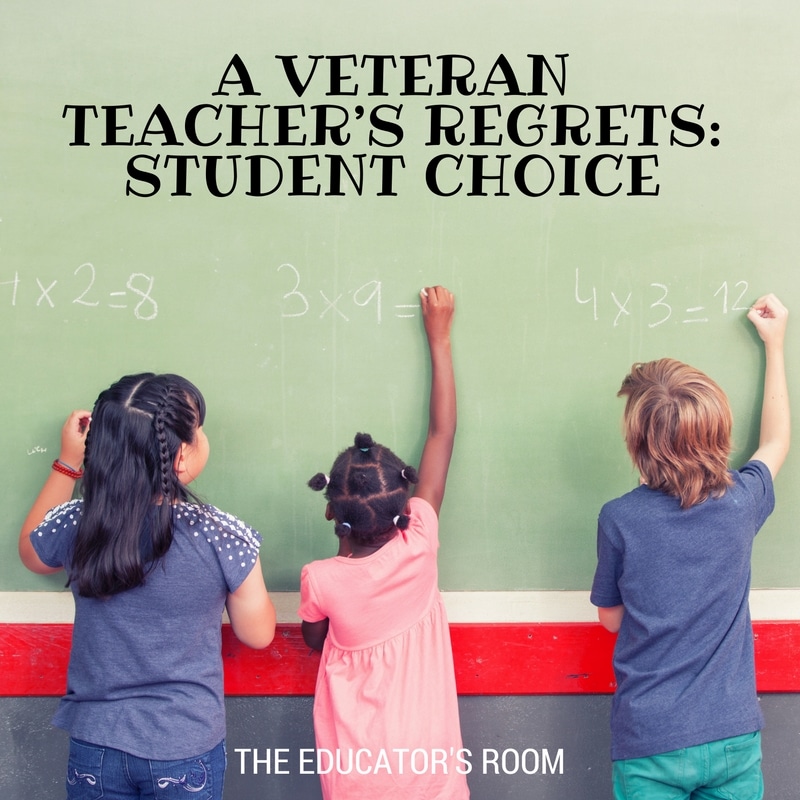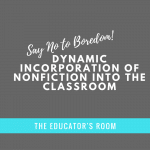In my classroom, I integrated student choice whenever I could. We did reading workshop every Friday, when students read an independent reading book of their choice. Whenever we did a personal essay or literary analysis paper, I let students choose their own topics and ideas. I started doing I-Search papers, where students chose their own questions to answer and then searched for the answers by interviewing experts, fifteen years ago. Writing workshop was one of the best times of the year.
But in terms of the day-to-day nitty gritty of the class, I was the one who decided what happened.
Even though I always knew that the most valuable, meaningful, and successful portions of the class were when students chose their own questions, topics, or texts to study.
So why didn’t I integrate more student choice into my classes? Like everything else in teaching and in life, it’s complicated, and, to butcher a famous quote, teaching was what happened while I was busy making other plans.
[fusion_builder_container hundred_percent=”yes” overflow=”visible”][fusion_builder_row][fusion_builder_column type=”1_1″ background_position=”left top” background_color=”” border_size=”” border_color=”” border_style=”solid” spacing=”yes” background_image=”” background_repeat=”no-repeat” padding=”” margin_top=”0px” margin_bottom=”0px” class=”” id=”” animation_type=”” animation_speed=”0.3″ animation_direction=”left” hide_on_mobile=”no” center_content=”no” min_height=”none”][bctt tweet=”The most valuable, meaningful, and successful portions of the class were when students chose their own questions, topics, or texts to study” username=”EducatorsRoom”]
Here are the reasons why I didn’t incorporate more student choice into my teaching.
I was still working within the system. I worked at a public school for the majority of my career. I wanted the diversity that came with that school, and I was glad to have the opportunity to teach students from all different socioeconomic backgrounds. But that also meant that I was a part of the system—and the system is big, it is run by people who often don’t have much classroom experience, and it is sometimes guided by the way things appear on the outside. They wanted to make sure that all kids had as similar an education as possible, and that usually meant doing the same thing as other teachers, especially with book choices and midterms.
I still had my own goals for my students, especially when it came to ideas. I admit to having my own social justice ideology that I sort of wanted to impress upon my students. I wanted them to see the injustice and inequality in the world, for example, and I wanted them to feel both responsible and empowered to do something about it. So I made my own questions to analyze the class structure in Twelfth Night rather than let students choose their own interpretation of any play they wanted. I specifically chose texts that would expose them to experiences that were not like their own. I wanted to push them and stretch their understandings and perspectives, and that doesn’t always happen when they choose the material.
It’s exhausting managing a class where everyone is doing their own thing. On the surface, Fridays might have looked like the easiest day of the week. And I think that’s what the impression that teachers had in other departments—how could we even call it teaching when the kids were just sitting around reading books? But honestly, I was more exhausted by the end of that day than I was after a day of discussion or group questions. Every single kid in the room was doing something different, and it was my job to keep them on task while at the same time maintaining a silent room, and maybe getting a little grading done as well. I would have loved to do something like that every day, but I don’ know if that model would have been sustainable.
I did what I could and gave myself permission for that to be enough. I can read about all the super star teachers who visited truant students at home or met with troubled students after school or created hand-made gifts to show their students how much they were loved and appreciated. But at the end of the day, I also needed energy for my own children, not to mention energy to get some exercise, make dinner, and perhaps throw a load of laundry in the washer. I lasted for seventeen years in the classroom, and I watched many teachers burn out before I did, and I think that one of the reasons why I made it that long was because I pushed myself just enough.
I still believe that giving students choice is the best way to gain their interest, to get them to do their best work, and to help them find their own voice.
But I also believe teachers have to take care of themselves first if they want to last in the profession.
[/fusion_builder_column][/fusion_builder_row][/fusion_builder_container]






